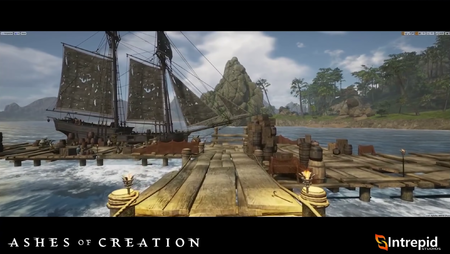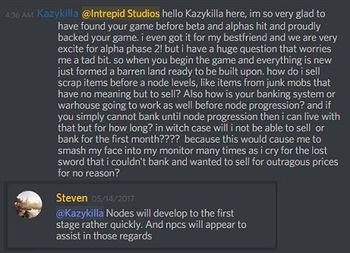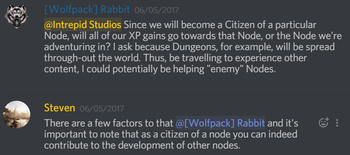Diferencia entre revisiones de «Node advancement»
(Created - DRAFT ONLY) |
(Add section) |
||
| Línea 2: | Línea 2: | ||
{{Node advancement}} | {{Node advancement}} | ||
| + | |||
| + | == Adaptive content == | ||
| + | |||
| + | {{Adaptive content}} | ||
| + | |||
| + | == See also == | ||
| + | |||
| + | * [[Node development]] | ||
| + | * [[Node sieges]] | ||
| + | * [[Progression]] | ||
{{Notes}} | {{Notes}} | ||
[[Category:Nodes]] | [[Category:Nodes]] | ||
Revisión del 17:07 18 nov 2017
La actividad de los jugadores, ciudadanos y no ciudadanos, como (questear, recolectar, raids, etc.) dentro de la ZOI de un nodo contabiliza para el avance de ese nodo en particular (progresión) a una fase superior.[1][2]
El avance de un nodo desbloquea sus ventajas únicas, aunque puede bloquear el avance de los nodos vecinos hacia sus siguientes fases, al incrementar su anillo de influencia.[3]
- Los nodos avanzan hacia su primera fase muy rápido. Esto habilita algunos PNJs como vendedores o el almacenamiento de objetos.[4]
- Cuanto más avanza el nodo, más ámplia se vuelve su ZOI.[5]
- Los nodos menos evolucionados (conocidos como nodos vasallos) que entran dentro de la ZOI de otros nodos pueden seguir ganando experiencia, pero siempre permanecerán en una fase inferior a la del nodo dominante.[6]
- El sistema de vasallaje comienza cuando un nodo alcanza la fase de Aldea (fase 3), sin embargo, los nodos vecinos a partir de la fase Expedición (fase 1)también bloquean el avance de sus propios nodos vecinos.[7][8]
- El algoritmo de expansión de territorio tiene en cuenta la costa más cercana, los nodos vecinos y el "mapa de calor" de los jugadores en las zonas circundantes durante las últimas semanas y meses.[9]
- Debido la forma en la que el algoritmo calcula la expansión del territorio (ZOI) durante el avance del nodo, hay una pequeña posibilidad de que nodos nodos en la misma fase terminen estando el uno cerca del otro.[10]
- The way that the algorithm expands the territories takes into account a few things: One it takes into account the coast like where's the closest coast. Two it takes into account the neighboring nodes so it can take over and essentially vassal state those nodes, but what's more important is essentially the initial population based on like how players choose their races. Because we have nine different races and four different starting points that branch out, each server's population density is going to dictate essentially the first few nodes that are highly populated and then that initial seed is what's going to determine the node structure as it moves inland into the into the world essentially; and based on the performance and successes of different sieges will determine which nodes that got locked out from the previous the initial advancements what nodes can now be available to advance further. So I really think that with so many variables that are present in the equation of how nodes advance and stay existing with the more variables you have, the higher likelihood there is for there to be a significant diversion in world progression.[9] – Steven Sharif
- Normally the algorithm that's applied to the node territorial expansion will prevent significant nodes from being in close proximity to each other... There could be a perfect storm where all of the algorithmic progression of territory leads to having these nodes very close to each other because there's certain requirements that should that need to be available to satisfy node vassal takeovers; and it's possible that two nodes would never take each other over as vassals and end up close together and spanning their territories in opposite directions: The Tale of Two Cities thing.[10] – Steven Sharif
- Un nodo no recibirá experiencia de los nodos dentro de su ZOI hasta que ese nodo no haya alcanzado su límite.[6]
- Los ciudadanos de un nodo pueden contribuir al avance de otros.[11]
- El porcentaje de experiencia que ganan los nodos será equitativa entre los cuatro tipos de nodo.[12]
- Different people have different resources invested in nodes progressing and it would be a little "gamey" if you could know exactly what was necessary at that point because that would disincentivize people from participating.[13] – Steven Sharif
La mejora del nodo mostrará una serie de animaciones y efectos visuales (dentro del área del nodo).[14][1]
- Los jugadores serán desplazados a zonas seguras si se cruzan con nuevos objetos generados durante el avance del nodo.[14][15]
- Los recursos aparecerán al rededor del nodo y el sistema mostrará una serie de caravanas llegando al nodo con esos recursos. Estas caravanas no podrán ser atacadas.[14]
- Algunos PNJs comenzarán con actividades de construcción.[14]
- Los jugadores fuera del nodo podrán ver como el aspecto del nodo va cambiando a medida que avanza hacia su nuevo nivel.[14]
- The Development Area of a Node is where civilization will appear as the Node advances. As the Node Stage increases, different buildings, NPCs, and services will become available in the Development Area. The higher the Node Stage, the more complex and populated the Development Area becomes. Development Areas will also vary depending on the Node Type - Economic, Military, Scientific, or Divine.[1] – Margaret Krohn
Adaptive content

This is actually a dynamic POI. This one will evolve as players evolve the node that it's attached to. So this is its final state.[16] – Jeffrey Bard
Los nuevos puntos de interés (como las mazmorras, jefes de mundo, y zonas corruptas) aparecen conforme los nodos se desarrollan.[17][18]Este contenido se adapta a la progresión del nodo de la zone donde se encuentra.[16][19]
- Aparecerán Edificios adicionales.[16]
- Aparecerán Enemigos adicionales.[16]
- Diferentes antagonistas/líderes con diferentes arcos de historia.[16][19]
- La población cambiará.[19]
- La dificultad del contenido cambiará.[19]
- El contenido puede ser completamente diferente.[19]
- Ganchos de misiones diferentes.[16]
- Las mazmorras se desbloquean cuando el nodo avanza a determinadas fases.[20]
- Múltiples nodos cercanos puede influir de forma colectiva en PDIs (Puntos de interés) más grandes.[21]
- Las mazmorras más grandes obtendrán contenido de mayor nivel a medida que avancen los nodos cercanos.[22][23]
- Los objetivos de la historia para los jugadores en las mazmorras dependerán de los arcos de historia elegidos a través del sistema de nodos.[20]
- Las tablas de drop de zonas y mazmorras dependerán del avance de ciertas áreas.[20]
- Los eventos de punto de interés son eventos relacionados directamente con determinados puntos de interés (POI).[24]
- La ubicación de los puntos de interés será la misma en cada servidor, pero algunos servidores pueden tener acceso limitado o inexistente a los mismos.[25]
- Certain dungeons and other points of interest across the map will all be affected by the server’s node development. Some dungeons will only be unlocked if nodes are developed to certain stages. The storyline objectives for players inside dungeons will also be dependent on the story arc paths chosen through the node system. The drop tables in area and dungeons will also be tied into the progression of certain areas. For example, let’s say that the humans have developed a node in Region A, and a storyline has opened up that leads players to inspect the ruins (dungeon) of a nearby area. And let’s say that this node was developed in a scientific (crafting) zone… Well before the node developed, this dungeon was accessible… But now the dungeon has propagated new monster assets that include a drop table catering to a crafting emphasis because of the development of that academic node. And perhaps, a new boss appears in different rooms of the dungeon that includes different adventure quest starts, like a mysterious item with a storyline that can only be progressed if a node develops to the metropolis stage in a certain region, across the world. Our system is so vast, when it comes to interconnectivity and how the world reacts to the players.[20]
Ver además
Referencias
- ↑ 1.0 1.1 1.2 Blog - Know Your Nodes - Advance and Destroy.
- ↑ A reactive world - Nodes.
- ↑ Vídeo, 2017-04-20 (0:02).
- ↑

- ↑ Node series part II – the Metropolis.
- ↑ 6.0 6.1 Transmisión en vivo, 2017-10-16 (50:20).
- ↑

- ↑

- ↑ 9.0 9.1 Entrevista, 2020-07-18 (10:04).
- ↑ 10.0 10.1 Entrevista, 2020-07-08 (1:00:15).
- ↑

- ↑ Transmisión en vivo, 2021-09-24 (1:21:23).
- ↑ 13.0 13.1 Transmisión en vivo, 2017-05-26 (28:16).
- ↑ 14.0 14.1 14.2 14.3 14.4 Transmisión en vivo, 2022-10-14 (55:13).
- ↑ Transmisión en vivo, 2017-11-17 (55:27).
- ↑ 16.0 16.1 16.2 16.3 16.4 16.5 16.6 Transmisión en vivo, 2021-03-26 (50:33).
- ↑ Transmisión en vivo, 2021-03-26 (22:53).
- ↑ Transmisión en vivo, 2017-11-17 (36:22).
- ↑ 19.0 19.1 19.2 19.3 19.4 Transmisión en vivo, 2017-11-17 (18:29).
- ↑ 20.0 20.1 20.2 20.3 MMOGames interview, January 2017
- ↑

- ↑

- ↑ Transmisión en vivo, 2020-07-25 (46:08).
- ↑ Transmisión en vivo, 2022-04-29 (40:21).
- ↑
